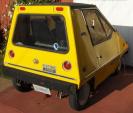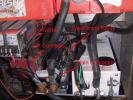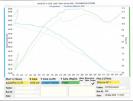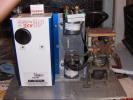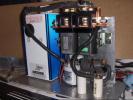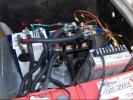| Owner | Tom & Jackie Keenan | ||||||
|---|---|---|---|---|---|---|---|
| Owner's Other EVs | 1989 Ford Escort LX 1980 Comutacar | ||||||
| Location | Alameda, California United States map | ||||||
| | |||||||
| Vehicle | 1976 Sebring-Vanguard Citicar Yellow Citicar. Aluminum tube frame, plastic (Cycolac/ABS) body. Main production with Terrell differential and 3.5hp motor. Manufactured September 1975; 1976 model year. | ||||||
| Motor | General Electric 5BC 49 JB 32 0 - 3.5 HP Series Wound DC Data plate info - Rating 3200 RPM - about 28.5 MPH Max is likely 5k RPM - about 44.6 mph 3.5 HP 36 VOLT 98 AMP CLASS F FRAME 49 Shaft - 16 spline, 13/16" (about .832") diameter Motor weight is 51.8 lbs | ||||||
| Drivetrain | Direct drive transaxle - 7.125:1 reduction | ||||||
| Controller | Alltrax 7245 New controller is an Alltrax and is MUCH more enjoyable to drive - no more herky-jerky accel-decel and no contactor clunking/arcing. Original contactor type controller provided three speeds - Low (8 MPH) Medium (19 MPH) and High (32+ MPH). As the speed limit is 25 MPH for nearly all of the island where I live, it was a constant accelerate-decelerate to keep around 25. Controller is very quiet (no noise/no whine - silent) and does not warm up at all. Just slightly warmer than ambient temp after my commute, 5 miles or so each way. | ||||||
| Batteries | 6 US Battery 8VGC, 8.00 Volt, Lead-Acid, Flooded I replaced the HV pack on August 29th, 2007. As of December 2011 the pack is just about 4 1/2 years old and showing some signs of aging.Experimented with 64 volts for a while, but the smallish 3.5 hp motor needed a cooling fan modification in order to handle the increased power. Now returned to 48v. | ||||||
| System Voltage | 48 Volts | ||||||
| Charger | Lester Puts out 25 amps @ 48v nominal. Typical ferroresonant charger (transformer type) but fairly efficient. | ||||||
| Heater | I converted a cheap $10 ***Mart heater by removing the 110VAC fan, and replacing it with a 48VDC computer rack fan. The heater didn't put out much heat (about 8 degree rise on high setting) so I cut both elements in half, and connected each half in parallel where the original entire element was connected. Now produces about 25 to 35 degree rise at about 15 amps or so (48V - about 700 watts). Works well as a defroster! | ||||||
| DC/DC Converter | Meanwell SD-200C-12 48/12 DC-DC converter installed at the same time as the new battery pack. Small 12v gel cell in parallel with the DC-DC converter. Component load info - (12 volt items) Brake lights - 3.8 amps (2.8 with LED lamps) Turn signal - 2.0 amps (1.3 amps with LED lamps) Headlights - 7.85 amps (6.8 amps with LED tail lights, 5.2 amps with LED marker lights) Main contactor - .9 amp F/R + main contactor - 2.0 amps Reverse (includes F/R + main) 3.38 amps Wiper - 1.8 amps low, 1.4 amps high (odd, but true) 'Battery' meter - .9 milliamps @18V Alltrax 4845 - 1.6 milliamps 'stop', 5.0 milliamps when in control range. This is a 48 volt item. DC/DC converter 'idle' (12v disconnected) 90 milliamps 12 volt battery backfeeding DC/DC converter (DC/DC disconnected from 48V) 100 milliamps (12v aux) I installed a relay that controls power to/from the DC/DC converter to control static drain of both the 48 and 12v systems. | ||||||
| Instrumentation | E-F voltmeter (no numbers). Now that it is hooked to two 8 volt batteries (as opposed to three 6 volt ones) it indicates about 1 3/4 divisions lower when charged, or about 17.25 volts. Top division on meter is 19 volts, and each division is close to 1 volt - bottom division is 14 volts. Charged pack is 51+ volts. Speedometer/odometer is spot on compared to GPS. | ||||||
| Top Speed | 35 MPH (56 KPH) Field weakening mod used to get to 35 MPH; unweakened top speed is about 33 MPH with tired batteries. but it now gets there very easily. Top speed when it was tested at 64v was about 45 MPH, and was a completely different car - Much quicker to accelerate. Normal (48v) maximum at zero degrees is about 32 MPH (not field weakened) With field weakening activated, top speed is 35 to 36 MPH at 48v. When going downhill, I limit the speed to 45 MPH in order to not overspeed the motor. At 45 MPH, the motor is turning approximately 5,000 RPM. | ||||||
| Acceleration | 0-25 ~ 6.5 seconds. 0-32 ~ 16.0 seconds. (48v numbers) Alltrax controller seems to accelerate about the same as the old contactor setup. Newer Citicars (Transition Citicars and Comutacars) have 6HP motors and a Dana rear 5.17:1 axle resulting in a higher top speed, but slower acceleration. | ||||||
| Range | 25 Miles (40 Kilometers) Book says 'up to 50 miles' but does not meet spec due to fewer than original number of batteries and optimistic original specs. Lead (Pb) = Range (substitute Li or NiMH or your favorite battery type. More of 'em will get you farther) Voltage = Speed Amps = Acceleration. Typical range for most EVs is 3-5 miles per 65 pound PbA battery, and my Citicar makes the average at just over 4 miles per battery. On 27 June 2011 (two months before the pack's fourth birthday) I drove at typical city speeds (25 - 30 mph) stopping and accelerating from the typical amount of stop signs, red lights, etc. I stopped the test at 18.7 miles, but it felt like it still had about a half-mile of oomph left. At 19 miles and about four years old, it still has a bit over 75% of the original 25 mile range left. US Battery information says that a pack isn't considered worn out until it reaches 50% capacity. UPDATE - As of June 2012, the pack will go about 13 miles, so it is just about due for replacement. | ||||||
| Watt Hours/Mile | 240 Wh/Mile According to the KillAWatt meter, 240 whr/mile (input) averaged over the last three months. Equates to about 1.6 cents a mile using the EV discount rate our local electric utility company provides. At 'cruise' speed of 28 MPH, draws about 95 amps (from Alltrax logging utility). With expired 6 volt batteries, it used about 370 Whr/mile. Now that the pack is showing signs of aging, the Wh/mile is starting to creep upwards. | ||||||
| EV Miles |
| ||||||
| Seating Capacity | 2 adults | ||||||
| Curb Weight | 1,160 Pounds (527 Kilograms) As weighed on a certified scale. Lower weight than a typical Citicar as it only has six batteries (instead of the normal eight). | ||||||
| Tires | 145R12 (radials). Originally had 4.80 X 12 trailer tires which were incredibly bouncy. New tires are and are amazingly smooth in comparison. No significant change in range or speed compared to the old tires. Highly recommended 'upgrade' if you have old-school trailer tires. Radial tires are a significant comfort improvement in this vehicle at no expense to efficiency or performance. | ||||||
| Additional Features | Grocery shelf inside behind seats, owners/repair manual, removable side windows, locking doors, 110vac/25 amp@48v charger, solid state speed controller. LED tail lights use 1/2 amp less (total 1 amp less) than the stock incandescent ones did when the tail lights are turned on. Running lamps used to run 5.2 amps (park lamp setting) but now run around 2.3 amps with six LED running lamps installed. About $1 each. Field weakening activated by an additional relay can. Motor brushes were advanced five degrees from stock, but motor changed out and are now returned to stock position. Advancing the brushes in this motor requires drilling two holes in the motor just under 1/2" from the originals in order to rotate the brush holder / rear bearing mount. Presently using 75w/90 synthetic gear lube. With the transaxle warm, and near the end of a 20 mile drive, I was able to get to almost 37 MPH, about 1 MPH faster than normal. The Citicar appears to coast farther when well warmed up. Results after several months of driving - Wh/mile has improved a bit, but now appears to be dampened by the aging battery pack. Always something! | ||||||
| In April 2011, the motor had a short in the brush crossover links. One of the links was not properly connected to the brush holder, and shorted against the motor casing - copper snot everywhere! I replaced it with a stock motor. Not quite as efficient (perhaps 300wh/mile) or as fast (34 mph with FW; 33 without) as the modified motor (37/34) but this is with older batteries. In November 2009, I replaced the Alltrax 4845 controller with an Alltrax 7245. As part of the upgrade I replaced the worn out F/R contactor and installed a more robust Kilovac main contactor. The F/R contact points were pitted and burned by the old contactor-type speed control setup, and they weren't up to the task of giving a good solid connection that an electronic controller needs. As the new parts are configured differently (new Albright SW-202 F/R is more 'horizontal' than the old tower-type F/R) they are now remounted to fit in the existing controller box. See pictures for additional detail. Purchased in Southern California, towed on a U-haul trailer to the Bay Area - Fit with inches to spare. Trailer had less than an inch of clearance to the sides of the Citicar on either side. Loading worked out well with the ramp in back. Originally tried to put it in the back of a Toyota full-size truck, but it didn't seem too stable and would probably have been too heavy for the tailgate cables. Rebuilt the Terrell differential / transaxle in June 2008. Replacing all the bearings (common items - still available) ran about $110. You will need a hydraulic press to remove and reinstall the bearings as the cheapo $19.99 puller will just bend. I ended up taking the gears and shafts to a transmission place, and they charged $20 to remove and install eight bearings. Not bad... Rebuilding the transaxle didn't make it quieter. It is all straight-cut gears, and sounds like an old pickup in first gear. Kids and adults in neighborhood think the Citicar is more fun than a carnival ride. Front 'wedge' needs plastic (ABS/Cycolac) repair and paint. Sides are in good shape. Looks like someone painted it (front section) with a material not compatible with the plastic body. Purchased a plastic repair material called PlastiFix that seems to work wonders with the plastic body panel repairs. | |||||||
Copyright © 1997-2025 by Mike Chancey

